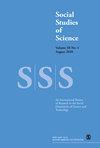From distance(s) to civilization(s): (Extra)terrestrial intelligence(s) of (post-) Soviet Armenian astronomy
IF 2.7
2区 社会学
Q1 HISTORY & PHILOSOPHY OF SCIENCE
引用次数: 0
Abstract
This article draws on post-positivist conceptualizations of distance in human geography to look at how Byurakan Astrophysical Observatory (BAO) astronomers identified with an ancient scientific-cultural legacy and how a corresponding imaginary bonded this legacy, BAO, and extraterrestrial intelligence. As part of the growing prospect of reaching out to other civilizations through radio waves in the 1960s, radio astronomers from Russian research institutes initiated the theoretical and empirical study of extraterrestrial civilizations and engaged with their Armenian counterparts. In so doing, they set a framework for contact through electromagnetic waves with extraterrestrial civilizations. Thereby, the epistemological constraints and affordances of astronomical distance gave rise to an (extra)terrestrial narrative of development. Armenian natural scientists responded positively to the study of extraterrestrial civilizations, though their engagement with this field remained passive. The scientific imaginary of extraterrestrial civilizations, however, contained pillars for the study of Armenian ancient astronomical past. As a result, when Soviet radio astronomy legitimized the study of extraterrestrial civilizations, it also legitimized the study of distant civilizations situated in the perceived historical past of the Armenian astronomical intelligentsia. In the rediscovery of ancient Armenia as an astronomical civilization by BAO (archeo)astronomers, national identity and historical continuity were at stake. Today, this imaginary continues.从距离(s)到文明(s):(后)苏联亚美尼亚天文学的(外)地智能(s)
本文利用人文地理学中后实证主义的距离概念,来研究比拉坎天体物理天文台(BAO)的天文学家如何认同一种古老的科学文化遗产,以及相应的想象如何将这种遗产、BAO和地外智慧联系起来。作为20世纪60年代通过无线电波与其他文明接触的日益增长的前景的一部分,来自俄罗斯研究机构的射电天文学家开始了对外星文明的理论和实证研究,并与亚美尼亚同行进行了接触。通过这样做,他们建立了一个通过电磁波与外星文明接触的框架。因此,天文学距离的认识论约束和启示产生了一种(外)地球的发展叙事。亚美尼亚自然科学家对地外文明的研究反应积极,尽管他们在这个领域的参与仍然是被动的。然而,地外文明的科学想象为研究亚美尼亚古代天文学的过去提供了支柱。因此,当苏联射电天文学使地外文明的研究合法化时,它也使亚美尼亚天文学知识分子所认为的历史上的遥远文明的研究合法化。在考古天文学家重新发现古代亚美尼亚是一个天文文明的过程中,国家身份和历史连续性受到了威胁。今天,这种想象还在继续。
本文章由计算机程序翻译,如有差异,请以英文原文为准。
求助全文
约1分钟内获得全文
求助全文
来源期刊

Social Studies of Science
管理科学-科学史与科学哲学
CiteScore
5.70
自引率
6.70%
发文量
45
审稿时长
>12 weeks
期刊介绍:
Social Studies of Science is an international peer reviewed journal that encourages submissions of original research on science, technology and medicine. The journal is multidisciplinary, publishing work from a range of fields including: political science, sociology, economics, history, philosophy, psychology social anthropology, legal and educational disciplines. This journal is a member of the Committee on Publication Ethics (COPE)
 求助内容:
求助内容: 应助结果提醒方式:
应助结果提醒方式:


